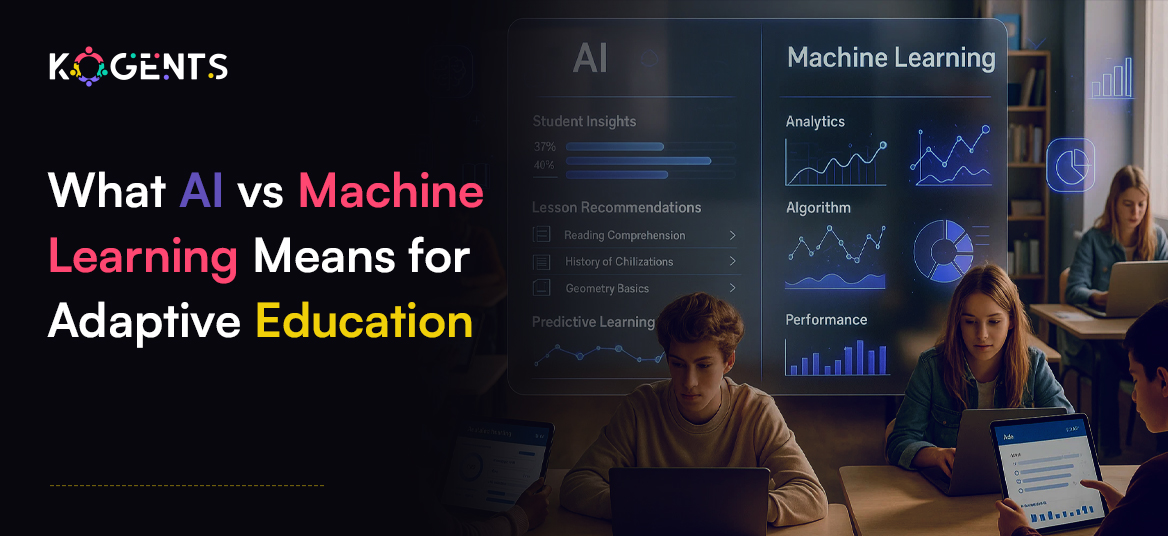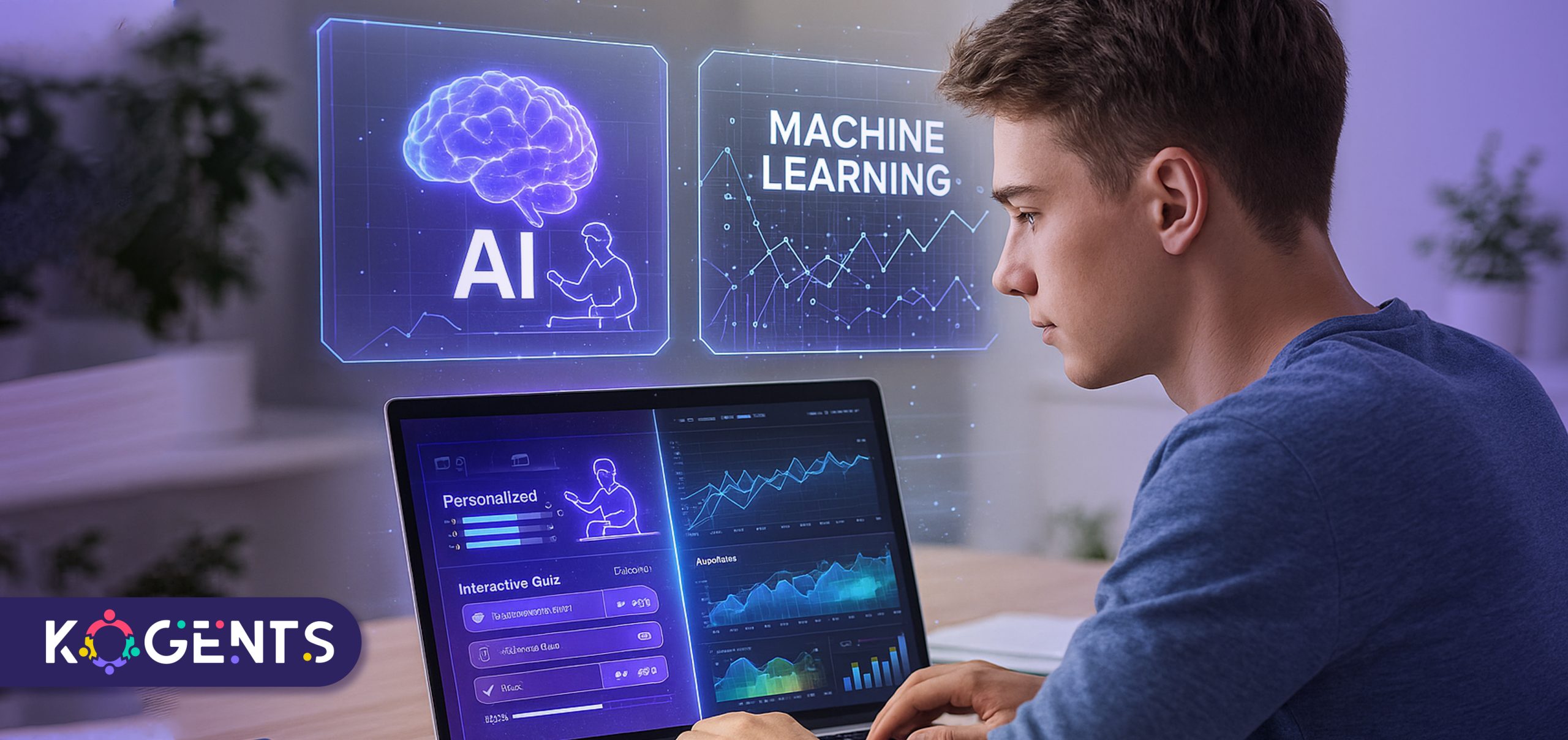What AI vs Machine Learning Means for Adaptive Education

Summary:
The difference between AI vs Machine Learning is shaping the next era of learning.
Adaptive education, systems that modify content in real time based on learner behavior, is now central to how students, professionals, and businesses acquire skills. A report from McKinsey notes that companies implementing AI in education see up to a 30% improvement in efficiency.
Universities like Stanford AI Lab are pioneering adaptive systems that promise highly personalized learning. For entrepreneurs and solopreneurs, adaptive education opens doors to scalable products, efficient employee training, and customer onboarding platforms.
This article unpacks AI vs ML in adaptive education: their features, benefits, limitations, future outlook, and case studies, all designed to give entrepreneurs and educators a roadmap. So, give it a read!
Key Takeaways
- AI vs Machine Learning drives adaptive education, offering personalized pathways and predictive learning.
- Features include personalization, automation, predictive insights, real-time feedback, and scalability.
- Benefits include improved engagement, efficiency, and ROI for learners, educators, and entrepreneurs.
- Challenges that can be witnessed are data privacy, algorithmic bias, and high infrastructure costs.
- The future includes generative AI classrooms, immersive VR learning, and new EdTech careers.
- Real-world case studies prove adaptive education improves retention, reduces costs, and scales globally.
Defining the Basics: AI vs Machine Learning
- Artificial Intelligence (AI): The overarching field that builds systems capable of replicating or augmenting human intelligence.
- AI spans areas like robotics, natural language processing (NLP), cognitive computing, and automation.
- Machine Learning (ML): A subset of AI where algorithms improve automatically through data-driven learning.

Key Algorithms in Adaptive Education
- Supervised Learning: Models trained on labeled datasets (e.g., predicting exam results).
- Unsupervised Learning: Finds hidden patterns (e.g., clustering students with similar study habits).
- Reinforcement Learning: Improves via trial and error, like an AI tutor rewarding correct answers.
Neural Networks, Deep Learning & NLP
- Neural Networks simulate brain functions to track learning behavior.
- Deep Learning, pioneered by experts like Geoffrey Hinton and Yann LeCun, powers speech recognition and automated grading.
- NLP allows adaptive systems to converse naturally with students, think like chatbots and virtual tutors like IBM Watson Education.
How Adaptive Education Works with AI vs ML?
Adaptive education systems follow a structured workflow powered by AI and ML:
- Input (Data Collection): Collects learner activity, quiz responses, reading time, and clicks.
- Reasoning (Pattern Recognition): ML algorithms analyze performance and detect gaps.
- Action (Adaptive Adjustment): AI dynamically adjusts lesson content, simplifying, accelerating, or diversifying materials.
- Feedback (Continuous Loop): Learner outcomes are re-evaluated, refining personalization.
Example: A Coursera adaptive module, influenced by Andrew Ng’s ML course, might detect a learner struggling with linear regression.
The platform shifts to additional resources, quizzes, and explainer videos before advancing.
Core Features of AI vs Machine Learning in Adaptive Education
1. Intelligent Personalization
AI vs ML tailors learning at the individual level. AI agents for education ensure every quiz, lesson, and recommendation adapts in real time to the learner’s performance.
Example: Duolingo modifies grammar exercises instantly based on mistakes.
2. Real-Time Assessment & Feedback
Unlike traditional models, adaptive systems give instant evaluations, crucial for building confidence and correcting errors before they compound.
3. Predictive Insights
ML anticipates when learners might disengage or fail, enabling proactive interventions.
- Used in platforms like Knewton, predicting student dropouts weeks in advance.
4. Automation of Routine Tasks
- AI grading tools free teachers from repetitive marking.
- Automated scheduling personalizes pacing for each student.
5. Multi-Modal Learning Adaptation
AI supports diverse formats: video, VR simulations, gamified exercises, and text. Learners get content aligned with their preferences.
6. Scalable Support Systems
Entrepreneurs can serve thousands of learners with consistent quality. Coursera’s ML engine, for example, supports millions worldwide.

AI vs Machine Learning: What They Mean for Modern Learning
For Learners
- Engagement Boost: Personalized, gamified learning keeps motivation high.
- Learning Efficiency: Time spent focuses only on weak areas.
- Equity: NLP-based platforms support learners with disabilities or different native languages.
For Educators
- Reduced Burnout: Automation handles grading, tracking, and repetitive support.
- Actionable Data: Analytics reveal patterns in learning behaviors.
- Scalability: A single instructor can effectively manage large cohorts with AI assistants.
For Entrepreneurs & Solopreneurs
- ROI Gains: Adaptive platforms reduce training costs while increasing adoption.
- Market Differentiation: Offering adaptive features creates a competitive edge.
- Monetization Opportunities: Launching niche adaptive solutions (e.g., compliance training for SMEs).
Challenges & Limitations For Adaptive Education
1. Data Privacy & Ethics
Adaptive platforms depend on vast datasets, raising risks around GDPR, FERPA, and HIPAA compliance. Mishandling erodes trust.
2. Bias in Algorithms
ML models reflect their training data. If biased, they can perpetuate inequity, an issue flagged by IEEE Transactions on Neural Networks research.
3. Technical & Cost Barriers
- Developing adaptive systems requires high-cost infrastructure like AWS AI or Google Cloud AI.
- Smaller businesses face barriers without partnerships.
4. Balance Between Automation & Human Input
While automation boosts efficiency, over-reliance risks reducing human mentorship and emotional connection in learning.
AI vs Machine Learning vs Other Tools: Comparison Table
| Feature | AI | Machine Learning | Deep Learning | Data Science |
| Definition | Intelligent systems simulating humans | Subset of AI learning from data | Neural network-based ML subset | Broad field analyzing data |
| Focus | Decision-making & automation | Pattern recognition & adaptation | Complex computations | Extracting insights |
| Education Use | Virtual tutors, automation | Personalized pathways | Speech & vision grading | Predictive analytics |
| Complexity | High | Medium | Very High | Variable |
Future of AI vs Machine Learning in Education
Generative AI Classrooms
OpenAI’s ChatGPT and Google Gemini will create real-time adaptive lesson plans, changing the teacher’s role from content creator to mentor.
Immersive VR & AR
Companies like NVIDIA are experimenting with adaptive VR simulations—ideal for medicine, engineering, and language training.
Expanded Career Opportunities
Adaptive education will demand new expertise:
- AI curriculum designers blending pedagogy and technology.
- Data scientists specializing in education analytics.
- AI ethics consultants ensure fair systems.
Global Reach & Inclusion
Adaptive platforms will democratize education globally, reaching learners in underserved communities where teachers are scarce.
Case Study Highlights
Case Study 1: SME Training Startup
A European EdTech startup developed an adaptive learning platform for SMEs.
Employees received dynamic training modules customized to their job roles.
Results: Training time fell 40%, retention rose 65%, and SMEs reported 25% savings in L&D costs.
Case Study 2: Healthcare Adaptive Tutor
A U.S. hospital integrated AI-driven adaptive simulators into continuing medical education. Doctors received personalized training scenarios.
Results: Knowledge retention improved 45%, diagnostic accuracy increased 30%, and patient outcomes saw measurable improvements.
Case Study 3: Solopreneur Tutor Platform
A solopreneur launched an AI-powered language-learning platform.
The system adapted lessons based on pronunciation accuracy using speech recognition ML models.
Results: Engagement doubled compared to static apps, and subscription renewals increased by 50%.
Unlock the Power of AI vs Machine Learning in Adaptive Education!
As we’ve explored, the conversation around AI vs Machine Learning goes far beyond technical definitions.
In the context of adaptive education, these technologies are not abstract buzzwords; they are practical tools shaping how individuals, organizations, and entire industries learn and grow. Artificial Intelligence provides the overarching intelligence framework, while Machine Learning powers the ability to adapt and evolve through data.
Together, they enable adaptive systems to deliver personalized, predictive, and scalable learning experiences that traditional education models simply cannot match. For learners, this means more efficient progress and higher engagement.
For educators, it means reduced workload and actionable insights. And for entrepreneurs and solopreneurs, it opens new avenues to build, monetize, and scale innovative learning solutions.
The future is clear: adaptive education, driven by AI and ML, will redefine not just classrooms but businesses, healthcare, and professional training worldwide.
So, discover how Kogents AI empowers entrepreneurs, solopreneurs, and healthcare providers with adaptive AI solutions.
Give us a call at (267) 248-9454 or drop an email at info@portal.kogents.ai for further information.
FAQs
What is the difference between AI and Machine Learning?
Artificial Intelligence (AI) is the broad field of creating intelligent systems, while Machine Learning (ML) is a subset of AI that uses data and algorithms to improve automatically. In adaptive education, AI defines the overall intelligence, while ML powers real-time personalization.
Can you give examples of AI vs Machine Learning in real life?
Yes. Examples include Netflix’s recommendation system (ML predicting what you’ll watch) and IBM Watson Education (AI offering virtual tutoring). In adaptive classrooms, ML adjusts difficulty levels, while AI manages the holistic learning experience.
How is AI vs Machine Learning used in healthcare education?
Hospitals use AI-driven simulators to train surgeons, while ML algorithms personalize modules for nurses based on past performance. A U.S. hospital reported 45% higher knowledge retention using adaptive AI vs traditional training.
Which is better: AI vs ML for data analysis?
ML is generally better for data analysis since it specializes in finding patterns, making predictions, and classifying large datasets. AI adds decision-making and automation, making them most powerful when used together.
What are the best AI software vs Machine Learning platforms for education?
Popular platforms include Google AI, Microsoft Azure ML, AWS Machine Learning, Knewton, and DreamBox Learning. These tools power adaptive education systems used by schools and businesses alike.
Are there AI vs Machine Learning courses online with certification?
Yes. Top certifications include:
- Stanford Machine Learning by Andrew Ng (Coursera)
- MIT AI Professional Certificate
- Google AI/ML Certification
- AWS Machine Learning Specialty
AI vs ML for small businesses, what’s more useful
For small businesses, ML tools are usually the entry point, enabling predictive analytics, adaptive customer training, and automation. AI adds value later with chatbots, virtual tutors, and intelligent automation.
AI vs ML jobs and salaries, what’s the outlook?
According to Glassdoor and LinkedIn reports, demand for AI and ML roles is booming.
- ML Engineers: $110K–$150K annually.
- AI Specialists: $120K–$160K annually.
- EdTech AI roles (curriculum designers, adaptive system developers) are rapidly growing.

Kogents AI builds intelligent agents for healthcare, education, and enterprises, delivering secure, scalable solutions that streamline workflows and boost efficiency.